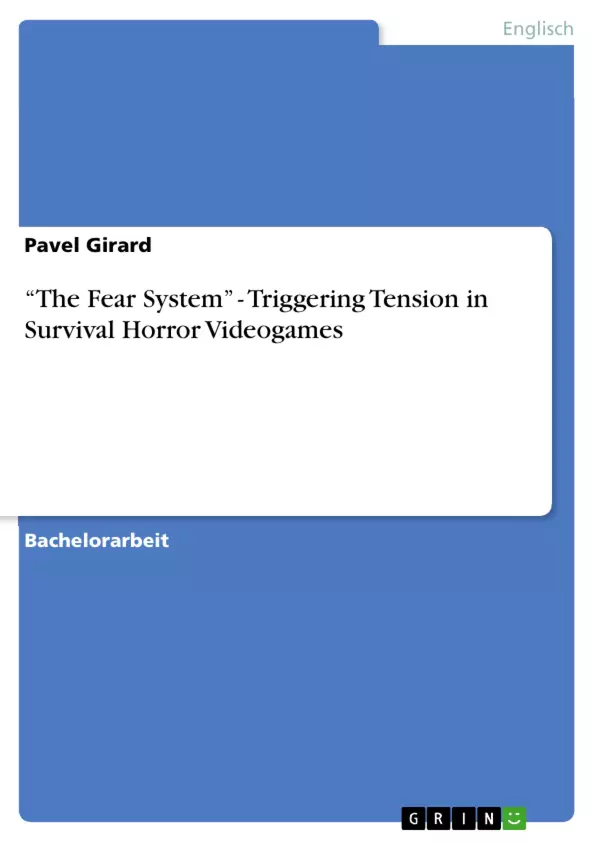In this paper, it is sought to find out in which ways so-called "survival horror" videogames manage to elicit tension in the player. This will be done from a cultural/media studies perspective. In the course of this analysis, it will be argued that not only tension itself, but also several other emotions proclaimed as “negative” and provoked by playing a certain game can bring about tension, such as unsettlement, stress or disgust. It is assumed that these emotions evoke a basically negative mood in players so that they are more susceptible to be scared. This assumption draws on the film studies-related “Excitation Transfer Theory” developed by Dolf Zillmann in 1988, which Lee and Peng felt free to adopt on games (327-45). They state that “residual excitement from previous game playing may serve to intensify a later emotional state of a game player” (328). By arguing that feeling unsettled or experiencing frustration or disgust are in fact forms of excitement, Zillmann’s theory can be related to the former argument. In the main part (chapter 4), a glance will be taken at the “videoludic staging of fear” (Roux-Girard 145) of two different survival horror game series: Resident Evil” (Capcom, 1996-99) and Silent Hill (Konami, 1999-2003). These specific series have been chosen, because, according to Picard (96), they are commonly said to be the most popular and the most representative ones within their genre. The series will first be analyzed individually in seperate chapters (though frequently referenced to each other), and will later be compared as a whole in the final conclusion. In the end, it is hoped that the following questions will have been answered:
1. What techniques are used by game developers to trigger tension in the player?
2. How do these techniques differ?
3. Which of the techniques are the most effective ones?
Inhaltsverzeichnis
- 1 Introduction
- 2 A Brief History of the Horror Videogame
- 2.1 The Origins of Videogame Horror
- 2.2 The Evolution of Videogame Horror
- 2.3 The Modern Videogame Horror
- 3 Approaching the Field
- 3.1 Academic Approaches in Game Studies: Narratology vs. Ludology
- 3.2 Linking Narratology and Ludology: The Approach of this Paper
- 3.3 Defining the Survival Horror Videogame: An Attempt
- 3.4 Immersion: Connecting the Player and the Game
- 3.5 Theories and the Method
- 4 Analysis of Resident Evil and Silent Hill
- 4.1 Resident Evil
- 4.1.1 Visual/Level Design Techniques
- 4.1.2 Gameplay Techniques
- 4.1.3 Audio Techniques
- 4.1.4 Narrative Techniques
- 4.1.5 Miscellaneous Techniques
- 4.2 Silent Hill
- 4.2.1 Visual/Level Design Techniques
- 4.2.2 Gameplay Techniques
- 4.2.3 Audio Techniques
- 4.2.4 Narrative Techniques
- 4.2.5 Miscellaneous Techniques
Zielsetzung und Themenschwerpunkte
Diese Bachelorarbeit befasst sich mit der Entstehung von Spannung in Survival-Horror-Videospielen. Sie untersucht, wie Entwickler von Spielen wie Resident Evil und Silent Hill Techniken einsetzen, um beim Spieler ein Gefühl von Furcht und Unbehagen zu erzeugen.
- Die Entwicklung des Horror-Genres in Videospielen
- Die Analyse von narrativen und spielmechanischen Techniken in Survival-Horror-Spielen
- Die Rolle von Immersion und Spannung im Spielerlebnis
- Der Vergleich von Techniken, die in Resident Evil und Silent Hill verwendet werden
- Die Bedeutung von Emotionen wie Unruhe, Stress und Ekel im Spielkontext
Zusammenfassung der Kapitel
Das erste Kapitel bietet eine Einführung in das Thema und definiert den Begriff des "Fear Systems" im Kontext von Survival-Horror-Videospielen. Das zweite Kapitel beleuchtet die Geschichte des Horror-Genres in Videospielen und betrachtet die Entwicklung von seinen Anfängen bis hin zu modernen Beispielen. Das dritte Kapitel untersucht verschiedene akademische Ansätze in der Game Studies, insbesondere die Beziehung zwischen Narratologie und Ludologie. Es wird auch erläutert, wie sich die beiden Ansätze in dieser Arbeit verbinden und eine Definition des Survival-Horror-Genres liefern. Schließlich wird der Begriff der Immersion und deren Bedeutung für das Spielerlebnis untersucht.
Das vierte Kapitel analysiert die beiden Spielserien Resident Evil und Silent Hill. Es untersucht die Techniken, die in diesen Spielen verwendet werden, um Spannung beim Spieler zu erzeugen, und betrachtet dabei die Bereiche Visual/Level Design, Gameplay, Audio, Narrative und Miscellaneous Techniques.
Schlüsselwörter
Survival Horror, Videospiele, Spannung, Furcht, Unbehagen, Immersion, Narratologie, Ludologie, Resident Evil, Silent Hill, Techniken, Gameplay, Leveldesign, Audio, Narrative, Emotionen.
- Quote paper
- Pavel Girard (Author), 2011, “The Fear System” - Triggering Tension in Survival Horror Videogames, Munich, GRIN Verlag, https://www.grin.com/document/177512



